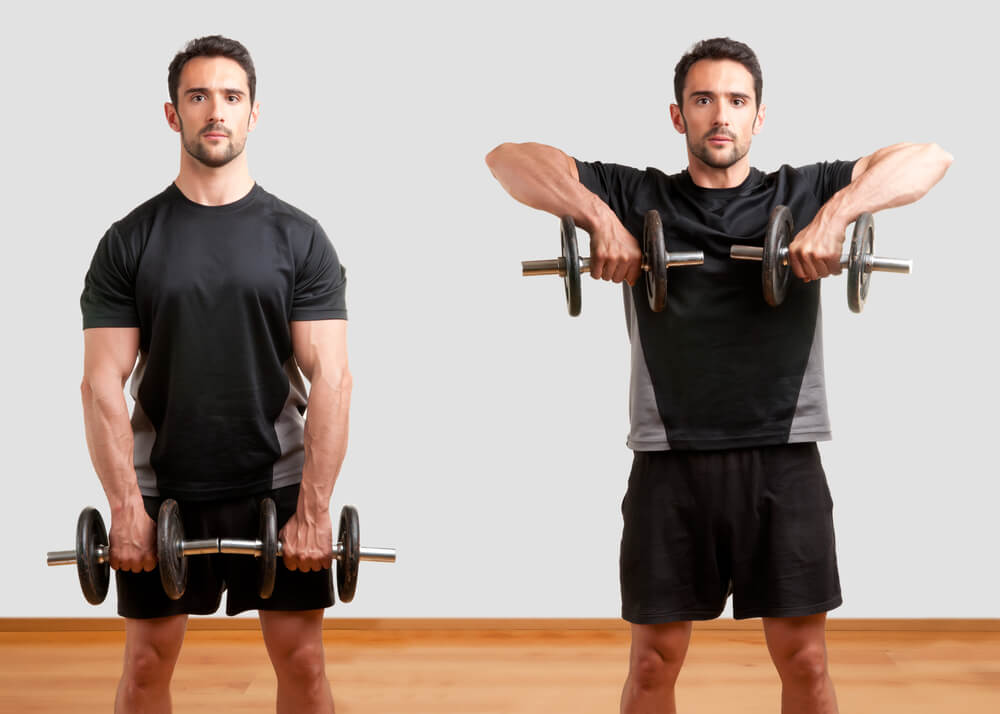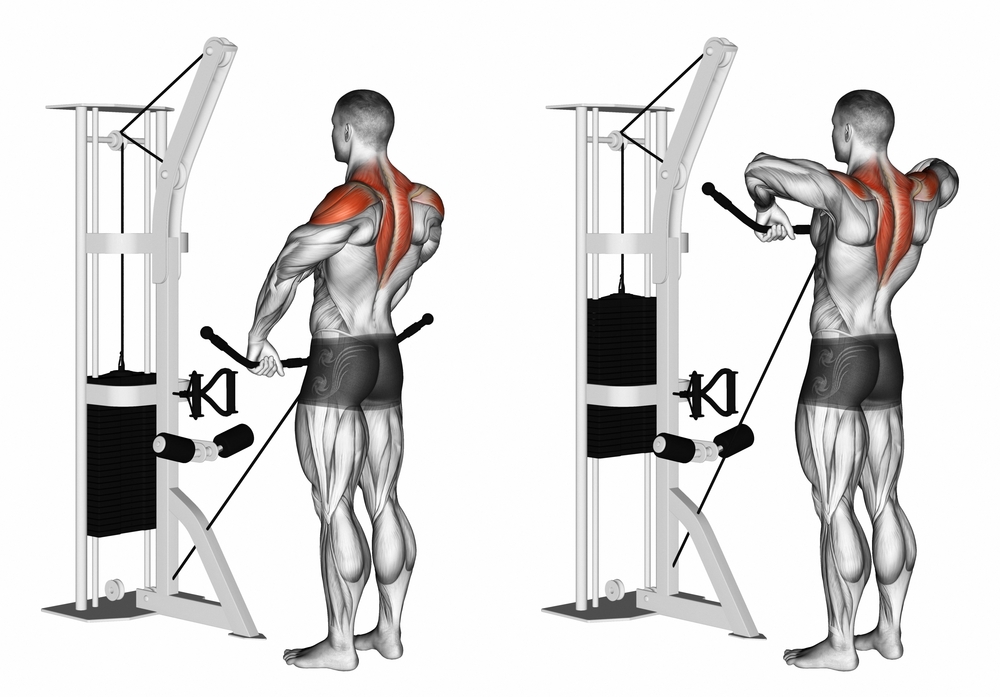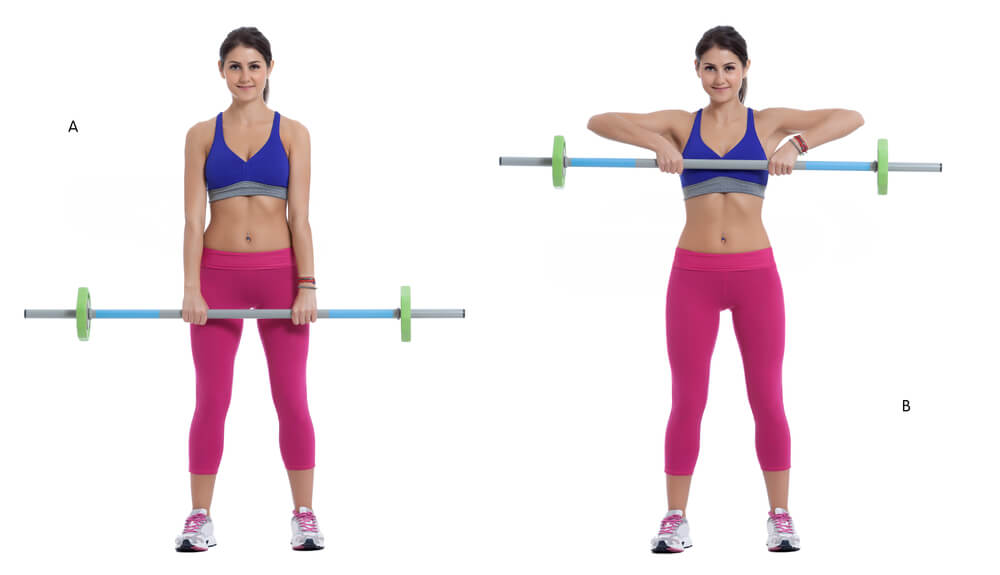Weight training is one of the best ways to both strengthen your body and tone it. One the best lifts are known as the upright row, today we will be exploring everything about this lift.
As your body breaks down muscle fibers during lifting, the body has to burn extra calories to repair the damaged areas. This is turn causes your body to burn more calories, even after you have finished your workout.
The upright row is just one of the many upper bodies lifts you can perform and add to a shoulder workout routine. Based on your current physical condition and the available equipment, there are many ways to perform the upright row.
Whatever equipment is available though, you need to make sure to lift correctly, otherwise, you open yourself up to possible injuries.
What is the Upright Row Exercise?
The upright row is a rather straight forward, weighted routine. Regardless of the equipment used during the workout, you will stand with your feet shoulder-width apart.
Your arms will be in front of you, knuckles facing outward as you hold onto the weighted object, whether it be a barbell, cable or another piece of equipment. Keeping your back straight and your knees slightly bent, you pull the weighted object up, keeping your knuckles facing outward until your hands reach your chin. From there, your arms are then lowered back down to the original, starting position.
This is a single rep of the upright row exercise.
Available Equipment For an Upright Rows
Do you wish you could work out more at home and ditch the overcrowded gyms?
If so, you’re in luck because this is one lift you can do with all sorts of different equipment. Some of the equipment you don’t need to spend much money on either.
Now, each piece of equipment does come with specific benefits, so if you have an assortment of options available, consider each and determine what works best for you.
Barbell Upright Row
The first option is a barbell upright row.
The barbell is what you would use on a bench press (although you may decide to go with a slightly smaller barbell as a full-sized, 45-pound bench press bar may simply take up too much space). Using a barbell is beneficial as it causes your body to stabilize the barbell. This forces smaller muscles in your arms and chest to activate.
The stabilizer muscles are not always used in other workouts and equipment.
Generally speaking, when possible, it is almost always better to use free weights such as a barbell over a machine when possible. Just make sure to keep the bar parallel to the floor when lifting. If the bar begins to tip it means one side is lifting more of the weight than the other.
Dumbell Upright Row
If you want the most out of your workout with traditional weights, but a barbell is not an option, consider using a dumbbell.
Instead of using a single weight, each arm will have its own weight. This alone provides you with benefits no other variation of the upright row is able to deliver. Because each arm has its own weight, each arm is forced to lift the same amount of weight.
In nearly all other forms of the exercise (there is a slight exception), a weaker arm can rely on the stronger, dominant arm to lift. Using dumbbells also makes it an easier workout to perform at home.
Like the barbell lift, you will work stabilizer muscles within your arms, wrists, and chest you would not in other exercises.
Cable Upright Row
The cable upright row is a popular move at the gym. Most gyms will have this available simply because it does not take up much space and is part of a larger lifting machine.
Most gyms will have this available simply because it does not take up much space and is part of a larger lifting machine. Ideally, you should use a barbell or dumbbell, but if those are not available, the cable is suitable.
The cable upright attaches to a weight machine at the bottom. There are a chain and pulley system that connects to a straight handlebar.
Make sure to use the handlebar attachment and not the dual rope or curl bar as these will work different areas of the body (not that working the other areas of the body is bad, but if you want to perform an upright row you want the cable to feature a straight bar, just like the barbell and dumbbell).
The cable will work your muscles in an ever-so-slightly different direction. This is because you are not able to directly stand above the pulley system. The pulley system attaches to the weights at the floor in front of you, so there is a slight directional pull. Additionally, this method of performing the upright row will not work the stabilizer muscles as the free-standing weight methods will.
The cable will work your muscles in an ever-so-slightly different direction. This is because you are not able to directly stand above the pulley system. The pulley system attaches to the weights at the floor in front of you, so there is a slight directional pull.
Additionally, this method of performing the upright row will not work the stabilizer muscles as the free-standing weight methods will.
Smith Machine Upright Row
The Smith Machine is essentially a combination of the barbell upright row and the cable variation.
With the Smith Machine, you have the larger barbell and weights. However, it is positioned on a loading rack, which prevents it from shifting in either direction. Because there is no possibility of a shift, you will work the stabilizer muscles the least in this method. While you can perform the workout without the slightly off lifting angle (as is the case with the cable start), it is realistically the least desirable lifting method for the upright row because almost no stabilizer muscles are worked during the lift.
With the Smith Machine, you have the larger barbell and weights.
However, it is positioned on a loading rack, which prevents it from shifting in either direction. Because there is no possibility of a shift, you will work the stabilizer muscles the least in this method. While you can perform the workout without the slightly off lifting angle (as is the case with the cable start), it is realistically the least desirable lifting method for the upright row because almost no stabilizer muscles are worked during the lift.
Resistance Bands Used For Upright Rows
The last option is also the most portable option.
You don’t always need to have weights around to perform an upright row. Resistance bands are a great way to workout when you travel, so if you’re on the go a good amount of the time and never know what kind of gym will be at the hotel (or if it will even have a hotel) this is an excellent option. The resistance band is a single, stretchable rubber with a handle on each side.
Different rubber strengths represent different weight levels.
It should say on the packaging the weight similarity right on the packaging. To perform an upright row with a resistance band, hold each handle just as you would if you were performing the move with dumbbells. Then, step on the band and keep it between your foot and the ground. This becomes the point of resistance. If it is too stretchy just push more of the band between your feet until you find the right amount of leverage to work your arms. From here, lift just as you would with dumbbells.
As a rule of thumb when using resistance bands. Always check the connection point of where the band attaches to the handle.
If you are tightening the resistance band for the row exercise, it puts added strain on where the handles attach to the band. Simply make sure it is in a good position so that the handles won’t snap off. Because the band is elastic, it can prove slightly dangerous if it whips off while fully taught.
Muscles Worked During Upright Row Exercise
As this is an upper body workout, it focuses on strengthening three major muscle groups. These are the deltoids, the trapezius and the biceps (Teach Me Anatomy, 2017). Depending on how you are lifting, you can add in the triceps to this list as well. Lifting with the cable will significantly handicap your ability to work the triceps as the pulley system pulls back automatically.
This is also the case (although not as much) with the elastic bands.
When using a barbell, dumbbell or even the Smith Machine, if you lower the bar back slowly to starting position it will work all of the reverse muscle groups. Ideally, try to take just as long lowering the bar (if not longer) than it takes to lift the bar up.
The biceps and triceps are the front and back of your arm. While the biceps seem to be a singular muscle, it is actually two different muscles packed together. The Short head of the bicep is the interior of the muscle while the Long head is the exterior of the muscle. On the flip side, the triceps, also known as the triceps brachii, is made up of three different bundles of muscle tissue. The Long head is the portion of the muscle that is closest to the back. The Lateral head fibers make up the exterior muscle, while the Medial head goes under the Long and Lateral.
The trapezius muscle is one of the larger muscle groups in the body. It runs from the base of your skull down along your spine to the middle of your back. It makes up the back of your neck and your shoulder down to around the shoulder bone. The trapezius is made up of three different parts. The Superior fibers is the tissue that makes up the neck and top of your shoulder blade. The Middle fiber is a strip that runs from shoulder bone to shoulder bone, and the Inferior fibers is a large triangle, connecting to the bottom of the Middle Fibers and reaching to a point in the middle of your back.
The deltoid muscle is the muscle group that goes directly over the shoulder bone. The trapezius muscles connect with the deltoid. The deltoid, while a smaller muscle, is broken down into three parts. The Anterior part is the front portion of the muscle.
The Lateral part of the muscle is in the middle and the Posterior is the rear portion of the muscle.
Where Do I Put My Hands For Upright Rows?
The placement of your hands does have an impact on what muscle groups you work more (or less) of.
While you will always hit the three major muscle groups mentioned above (as well as the triceps, depending on how you lift), the amount of strain you place on each will vary. Altering your grip is easiest when using either a barbell or a Smith Machine. The narrower the grip you use, the more of your trapezius muscles you work. If you use a wider grip, more of the lift is placed on the deltoids.
For the most part, the biceps will be used equally, no matter how your grip is.
When to Avoid the Upright Row
Do you ever feel a tweak in your body when performing a certain lift?
Is there any kind of sharp pain that comes out of nowhere?
If so, it’s your body telling you something. Now, from time to time you might experience a muscle spasm or even a pinched nerve. This usually has more to do with being dehydrated and repeated movements you perform throughout the day. However, if you feel a very specific pain whenever you perform a certain lift it means you need to stop the move, talk to your doctor and, at the very least, find an alternative move that can still provide you with similar benefits only with less pain.
The upright row can have some negative effects on some people. This is mainly due to repeat internal rotation performed with often heavyweights. This places a considerable amount of pressure on the humerus.
Due to this, if you suffer from pain while performing the upright row there are a handful of alternatives for you to consider.
For starters, while the exercise usually requires you to lift the weight up so your hands are near your chin, you may want to stop right before you reach chest level. This reduces the impact on your rotator cuff. Other workouts you may want to consider instead of the upright row, should pain continue (or develop) includes a shoulder shrug and a lateral raise. The shoulder shrug works your trapezius and the lateral raise works your lateral deltoids.
Recommended Upright Row Workout
First, you need to ask yourself, do you want to build size or go for a lean, cut look?
If you’re going for size, you’ll want to lift heavier weight with fewer reps. If you want the lean, cut look, go for more less weight and more reps.
Going for Size:
Select a weight you can lift anywhere from 5 to 7 times before failure.
Perform one set, then complete the first circuit of your lifting routine.
Repeat the lift. If you were able to lift all 7 times, go to a heavier weight the second time through. If you hit 7 each time you’ll want a heavier weight the next time you do upper body/back workouts.
Going for Lean:
Select a weight you can lift between 10 and 15 times.
Perform one set and then complete the rest of your lifting circuit.
Repeat the lift with the same weight. If you max out at 15 both times you’ll want to increase your weight the next time you do upper body. If you don’t, your body will become accustomed to the weight and you won’t receive as many benefits from the lift.
Conclusion
If you’re looking to strengthen your upper body, the upright row is one of the better-weighted exercises around. With an assortment of equipment options available for performing the exercise, it is a workout just about anyone can do. However, as is the case with any other kind of exercise, it is always important for you to practice correct posture and form.
Enjoy using upright rows in your next workout!
-Terry Asher
Terry Asher
Latest posts by Terry Asher (see all)
- Better Family – Product Review Liquid Daily 2 oz - Dec 16, 2024
- Post-Workout Recovery: The Key to Optimal Performance - Nov 25, 2024
- Pre-Workout Supplements – Everything You Need To Know - Nov 18, 2024














Another great newsletter -Thank You
Hey Richard,
Thanks, man I appreciate it! Let us know if you need anything…
-Terry Asher
For some reason face pulls with the rope seem to get me much more sore in the delts than the upright rows do.
Brain,
I’d have to agree with you, I think for rear delts face pulls are more effective. However upright rows are solid for the lateral muscle fibers.
Thanks for your insight…
-Terry Asher
Hey Terry,
Thanks for providing step-by-step instructions on performing upright rows. As one of my favorite exercises for targeting the shoulders, I love how it can be performed in a number of ways as exemplified in your post. My favorite way to do upright rows are with a pair of dumbbells, but the resistance band idea sounds great as well given the increase in range of motion, which is also important when working out the shoulders. Thanks for the quality post!
Pete
Hey Pete,
Appreciate the compliment and glad you enjoyed the info! Yea I enjoy mixing it up and like you said you can hit different angles & get more range of motion.
Thanks for stopping by!
-Terry Asher
thanks for the awesome suggestions. Nice article it is